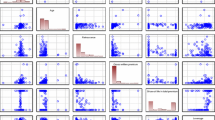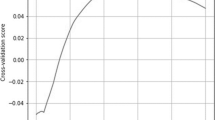Abstract
It is a well-known fact that heterogeneity is one of the characteristics of the insurance market, and it is relevant to classify and characterize companies by means of their financial properties and different risk profiles. So, it may not be adequate to use a general model for all the companies operating in the European market, as the one proposed by the Directive 2009/138/CE. Solvency II is a general regulatory model such that the volume of own resources will be determined depending on risks based on a calibration reached considering the average behaviour of companies. In order to criticize this approach, we have obtained a characterization of the profiles of companies using a PAM clustering methodology, adapted for longitudinal data, and we have studied the evolution of the obtained groups of companies under a Bayesian approach. In this way, we have introduced a multinomial general dynamic linear model to study the probabilities of the companies to be included into each group. The characterization and identification of these groups suggest that an unique regulatory model may be unsuitable. We have used data from DGSFP (Spanish insurance regulator), with public information about the balance sheets and income statements from years 1999 to 2011.
Similar content being viewed by others
Notes
European Commission, Internal Market D.G. (2003): Solvency II—Reflections on the general outline of a framework directive and mandates for further technical work. MARKT/2509/03. Brussels, 3 March 2003.
Point (26) of the Preface expresses that “...The Solvency Capital Requirement standard formula is intended to reflect the risk profile of most insurance and reinsurance undertakings. However, there may be some cases where the standardized approach does not adequately reflect the very specific risk profile of an undertaking”.
This Article says: “Where it is inappropriate to calculate the Solvency Capital Requirement in accordance with the standard formula, as set out in Sect. 2, because the risk profile of the insurance or reinsurance undertaking concerned deviates significantly from the assumptions underlying the standard formula calculation, the supervisory authorities may, by means of a decision stating the reasons, require the undertaking concerned to replace a subset of the parameters used in the standard formula calculation by parameters specific to that undertaking when calculating the life, non-life and health underwriting risk modules, as set out in Article 104(7)”.
References
Abrahams A, Becker A, Sabido D, D’Souza R, Makriyiannis G, Krasnodebski M (2009) Inducing a marketing strategy for a new pet insurance company using decision trees. Expert Syst Appl 36(2):1914–1921
Agresti A (2002) Categorical data analysis, vol 359. Wiley, New York
Anghelache C, Armeanu D (2008) Application of discriminant analysis on Romanian insurance market. Theor Appl Econ 11(11):51–62
Ashby M, Neuhaus JM, Hauck WW, Bacchetti P, Heilbron DC, Jewell NP, Segal MR, Fusaro RE (1992) An annotated bibliography of methods for analysing correlated categorical data. Stat Med 11(1):67–99
BarNiv R, McDonald J (1992) Identifying financial distress in the insurance industry: a synthesis of methodological and empirical issues. J Risk Insur 59(4):543–573
Benston G, Smith C (1976) A transactions cost approach to the theory of financial intermediation. J Finance 31(2):215–231
Breiman L, Friedman JH, Olshen RA, Stone CJ (1984) Classification and regression trees. Wadsworth International Group, California
Breslow N, Clayton D (1993) Approximate inference in generalized linear mixed models. J Am Stat Assoc 88(421):9–25
Brockett P, Cooper W, Golden L, Rousseau J, Wang Y (2004) Evaluating solvency versus efficiency performance and different forms of organization and marketing in US property- liability insurance companies. Eur J Oper Res 154(2):492–514
Calinski T, Harabasz J (1974) A dendrite method for cluster analysis. Commun Stat 3(1):1–27
Cummins J, Weiss M (1991) The structure, conduct, and regulation of the property–liability insurance industry. Financ Cond Regul Insur Co 117–154
de Haan L, Kakes J (2010) Are non-risk based capital requirements for insurance companies binding? J Bank Finance 34(7):1618–1627
Dedu V, Armeanu D, Enciu A (2009) Using the multivariate data analysis techniques on the insurance market. Roman J Econ Forecast 4:170–179
Flórez-López R, Ramón-Jerónimo J (2009) Marketing segmentation through machine learning models. Soc Sci Comput Rev 27(1):96–117
Genolini C, Falissard B (2010) KmL: k-means for longitudinal data. Comput Stat 25(2):317–328
Gower J (1971) A general coefficient of similarity and some of its properties. Biometrics 27(4):857–871
Hadfield J (2010) MCMC methods for multi-response generalized linear mixed models: the MCMCglmm R package. J Stat Softw 33(2):1–22
Hadfield J (2011) MCMCglmm course notes. http://cran.r-project.org
Hsu K (2010) Using a back propagation network combined with grey clustering to forecast policyholder decision to purchase investment-inked insurance. Exp Sys Appl 38(6):6736–6747
Kass G (1980) An exploratory technique for investigating large quantities of categorical data. Appl Stat 29(2):119–127
Kaufman L, Rousseeuw P (1990) Finding groups in data: an introduction to cluster analysis, vol 39. Wiley Online Library, New York
Kramer B (1996) An ordered logit model for the evaluation of Dutch non-life insurance companies. De Economist 144(1):79–91
McCarty J, Hastak M (2007) Segmentation approaches in data-mining: a comparison of RFM, CHAID, and logistic regression. J Bus Res 60(6):656–662
McCulloch C (1997) Maximum likelihood algorithms for generalized linear mixed models. J Am Stat Assoc 92(437):162–170
Natarajan R, Kass R (2000) Reference Bayesian methods for generalized linear mixed models. J Am Stat Assoc 95(449):227–237
Ntzoufras I (2009) Bayesian modeling using WinBUGS, vol 698. Wiley, New York
Ntzoufras I, Dellaportas P (2002) Bayesian modelling of outstanding liabilities incorporating claim count uncertainty. N Am Actuar J 6(1):113–125
Pettitt A, Tran T, Haynes M, Hay J (2006) A Bayesian hierarchical model for categorical longitudinal data from a social survey of immigrants. J R Stat Soc Ser A (Statistics in Society) 169(1):97–114
Pirra M, Forte S, Ialenti, M. (2011) Implementing a solvency II internal model: bayesian stochastic reserving and parameter estimation. In Astin Colloquium. Madrid. http://www.actuaries.org/ASTIN/Colloquia/Madrid/Papers/Pirra_Forte_Ialenti.pdf
Plummer M (2003) Jags: a program for analysis of Bayesian graphical models using Gibbs sampling. In: Technical report (2003). DSC 2003 Working Papers
Quinlan J (1986) Induction of decision trees. Mach Learn 1(1):81–106
Sorensen D, Gianola D (2002) Likelihood, Bayesian and MCMC methods in quantitative genetics. Springer, Berlin
Treasury HM (2006) Solvency II: a new framework for prudential regulation of insurance in the EU. London, February
Trieschmann J, Pinches G (1973) A multivariate model for predicting financially distressed PL insurers. J Risk Insur 40(3):327–338
Van Gestel T, Martens D, Baesens B, Feremans D, Huysmans J, Vanthienen J (2007) Forecasting and analyzing insurance companies’ ratings. Int J Forecast 23(3):513–529
West M, Harrison J (1997) Bayesian forecasting and dynamic models. Springer, Berlin
Wils W (1994) Insurance risk classifications in the EC: regulatory outlook. Oxf J Legal Stud 14(3):449–467
Wu C, Kao S, Su Y, Wu C (2005) Targeting customers via discovery knowledge for the insurance industry. Exp Syst Appl 29(2):291–299
Acknowledgments
The authors would like to thank the referees for all their helpful comments that have greatly improved the paper.
Author information
Authors and Affiliations
Corresponding author
Annex I: Estimation of the multinomial state space model
Rights and permissions
About this article
Cite this article
Albarrán, I., Alonso-González, P. & Marin, J.M. Some criticism to a general model in Solvency II: an explanation from a clustering point of view. Empir Econ 52, 1289–1308 (2017). https://doi.org/10.1007/s00181-016-1107-3
Received:
Accepted:
Published:
Issue Date:
DOI: https://doi.org/10.1007/s00181-016-1107-3




